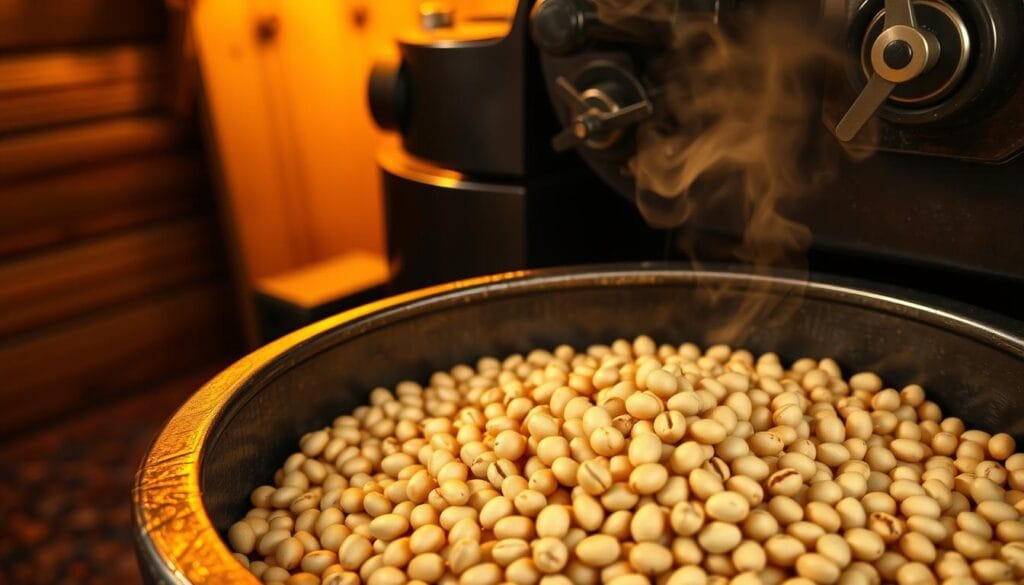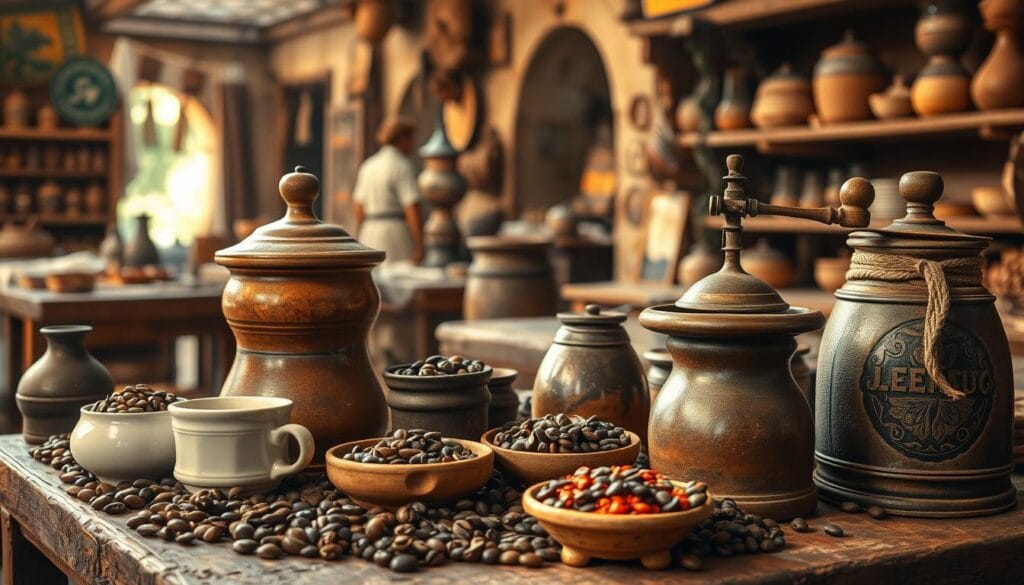My first taste of white coffee was like finding a hidden treasure. It was in a small café in Seattle. The barista showed me a brew that changed my coffee world. It is known for its light color and nutty taste, a new way to roast coffee beans.
It is different from dark roasts, and has a unique taste that challenges what you know about coffee. White coffee comes from Malaysia and is loved by coffee lovers in the U.S. With a strong caffeine kick, the roasting method makes it lighter and more complex.
Their beans are roasted differently than regular coffee. They’re roasted at lower temperatures for a shorter time. This keeps more of their natural flavors, making the coffee strong and gentle. The beans’ pale color shows the care and tradition in making this coffee.
Key Takeaways
- White coffee is a unique light-roasted coffee with Malaysian origins
- Roasted at lower temperatures for a shorter time
- Contains higher caffeine content than traditional coffee
- Offers a distinctive nutty flavor profile
- Represents an innovative approach to coffee preparation
Understanding White Coffee’s Unique Characteristics
It is a special type of coffee that breaks away from the usual roasting methods. It uses a unique process that changes the bean’s taste and chemical makeup.

White coffee has its own set of flavors that are different from the regular one. The light roasting keeps more of the bean’s natural chemicals. This creates a unique taste experience.
Chemical Composition and Properties
It is roasted in a way that keeps more chlorogenic acids and antioxidants. These special compounds add to its:
- Higher nutritional value
- Lower acidity than usual roasts
- More natural bean flavors
Distinctive Features of White Coffee Beans
The beans are top-quality arabica. They stand out because of:
- Lighter color from less roasting
- More caffeine
- Stronger raw bean tastes
Comparison with Traditional Coffee
| Characteristic | White Coffee | Traditional Coffee |
|---|---|---|
| Roasting Temperature | 325-350°F | 450-480°F |
| Coffee Intensity | Medium | High |
| Flavor Profile | Nutty, Mild | Bold, Robust |
It is a unique choice for those looking for something different. Its special roasting method brings out subtle flavors and health benefits, making it stand out from regular coffee.
The Historical Journey of WHITE COFFEE

Exploring the origins of it is a journey into a rich history. It all started in Ipoh, Malaysia, in the late 1800s. Local Chinese immigrants created a roasting method that changed coffee forever.
The history is tied to cultural innovation. In the Hainan community, people found a way to roast coffee with margarine. This made the coffee lighter and smoother, changing how people drank their coffee.
“White coffee represents more than a beverage – it’s a cultural heritage passed through generations of Malaysian coffee artisans.”
- Originated in Ipoh, Malaysia during the 1800s
- Developed by Chinese immigrant communities
- Unique roasting method using margarine
- Represented a significant coffee preparation innovation
It started spreading globally in the early 1900s. As Malaysian communities moved, they took their coffee traditions with them. This introduced white coffee to the world, making it a global favorite.
| Period | Key Development | Cultural Impact |
|---|---|---|
| Late 1800s | Initial Roasting Technique | Local Malaysian Innovation |
| Early 1900s | Regional Expansion | Growing Cultural Recognition |
| Mid-20th Century | International Introduction | Global Coffee Culture Influence |
Today, coffee lovers around the world celebrate white coffee. They enjoy its smooth taste and its rich history. From its start in Malaysian coffee houses to cafes worldwide, it shows the power of culinary creativity and cultural exchange.
Enhance your breakfast with cream of wheat recipes or learn how to cook it perfectly.
Traditional Malaysian White Coffee Heritage
It is a treasured part of Malaysian coffee culture, especially in Ipoh. It’s a brewing technique that turns coffee making into an art. This art shows the skill passed down through generations.
The story starts with the Chinese community in Ipoh, Perak. They came up with a special way to roast and brew coffee. They use margarine to roast the beans, making the coffee lighter and smoother.
Cultural Significance in Ipoh
Ipoh is famous for its white coffee worldwide. Local coffee shops, called kopitiam, are key places for this tradition. They are more than just places to drink coffee; they are where people come together.
- Represents local culinary innovation
- Symbolizes community gathering spaces
- Preserves traditional brewing methods
Evolution of Preparation Methods
Over time, making it has changed but stayed true to its roots. Today, roasters use better tools but still follow the old ways. This keeps the coffee’s true taste alive.
| Traditional Method | Modern Approach |
|---|---|
| Manual margarine roasting | Precision temperature-controlled roasters |
| Hand-ground beans | Industrial grinding techniques |
Regional Variations
Across Malaysia, it has its own special flavors. Places like Penang and Kuala Lumpur add their own twist. Each region makes the coffee its own way.
“White coffee is not just a drink, it’s a cultural narrative served in a cup.” – Malaysian Coffee Historian
The Science Behind Light Roasting Process
Exploring the roasting process shows the detailed science of white coffee beans. This method is different from dark roasts. It uses controlled temperatures and less heat to keep the bean’s natural traits.
The light roasting method changes coffee beans in a careful scientific way. Roasters watch the temperature closely, keeping it between 350-400°F. This is much lower than usual roasting. It helps the coffee beans keep their original makeup and nutrients.
- Temperature control is critical in light roasting
- Shorter roasting duration preserves bean integrity
- Minimal heat prevents complex chemical changes
During roasting, coffee beans go through small changes at the molecular level. The light roasting method keeps chemical changes to a minimum. This means you get a more real flavor and more caffeine than dark roasts.
“Light roasting is an art of preserving the bean’s original essence.” – Coffee Roasting Experts
Chemical reactions in light roasting are small. The beans keep more chlorogenic acids, which are good for health. You’ll taste a brighter, more acidic flavor that makes it stand out.
Knowing these scientific details helps its lovers see the careful work behind white coffee’s special making.
Unique Brewing Requirements and Techniques
Brewing white coffee needs precision and special knowledge. You must understand what makes white coffee different from other brewing methods.
It has its own brewing techniques that are different from usual coffee making. Learning these methods helps you get the best flavors from these special beans.
Optimal Water Temperature
Getting the perfect one requires careful temperature control. Unlike regular coffee, it needs a gentler approach:
- Water temperature between 195-205°F (90-96°C)
- Avoid boiling water to prevent flavor degradation
- Use a digital thermometer for precise measurement
Grinding Specifications
Grinding the beans needs a lot of attention to detail. Your brewing techniques should focus on:
- Extra-fine grind consistency
- Burr grinders recommended for uniform particle size
- Adjust grinder settings to prevent over-extraction
Equipment Considerations
Specialized equipment can make it better. Consider getting:
- Pour-over brewers with precise flow control
- Gooseneck kettles for accurate water distribution
- Digital scales for consistent coffee-to-water ratios
“The art of white coffee brewing is about precision and patience.” – Coffee Brewing Expert
Embrace these brewing techniques to improve your coffee making. They will help you unlock the unique qualities of it.
Flavor Profile and Tasting Notes
It gives you a unique taste experience. It’s lighter and more subtle than regular coffee. This makes it a special treat for coffee lovers.
The aroma of it is quite different. It’s roasted at lower temperatures. This keeps more of the natural bean’s scent. You get a lighter, more delicate smell that shows off the coffee’s true nature.
“White coffee reveals the purest essence of the coffee bean, capturing its most delicate flavor notes.” – Coffee Exploration Magazine
It is known for its:
- Nutty undertones with mild sweetness
- Lighter body compared to traditional roasts
- Reduced bitterness
- Subtle floral and herbal hints
Tasting it is remarkably different from regular coffee. It’s smoother and less acidic. This lets the coffee bean’s natural flavors stand out. If you like a milder, more complex coffee, white coffee is for you.
Health Benefits and Caffeine Content
It is a unique way to get your daily caffeine. It might also offer health benefits. Knowing its nutritional value and caffeine content helps you choose your coffee wisely.
Nutritional Value
It is packed with nutrients that boost your health. Its light roast keeps more of the coffee’s natural nutrients.
- Higher antioxidant content compared to dark roast coffee
- Rich in chlorogenic acid, which supports metabolism
- Contains essential minerals like potassium and magnesium
Comparative Caffeine Levels
It has more caffeine than regular coffee. Its special roasting method makes it stand out.
| Coffee Type | Caffeine Content (per 8 oz) |
|---|---|
| White Coffee | Higher caffeine (around 70-90 mg) |
| Medium Roast | Standard caffeine (65-70 mg) |
| Dark Roast | Slightly lower caffeine (60-65 mg) |
Potential Health Advantages
Drinking it daily might do more than just wake you up. Studies show it could have several health benefits.
- Enhanced cognitive function
- Potential metabolism support
- Reduced risk of certain chronic diseases
- Improved insulin sensitivity
“White coffee represents a fascinating intersection of flavor and potential wellness benefits.” – Dr. Coffee Research Institute
While it looks promising, it’s important to drink it in moderation. This way, you can enjoy its benefits without overdoing it.
Selecting Quality White Coffee Beans
Choosing the right arabica coffee beans is key for a great experience. It’s not just about picking a bag. You need to look at several important factors for quality and flavor.
When looking for top white coffee beans, focus on these key points:
- Roasting method: White coffee beans are lightly roasted
- Origin: Choose beans from famous coffee-growing areas
- Freshness: Make sure the roast date is recent for the best taste
- Processing technique: Know how the beans are made
Pro tip: Buy from trusted roasters who focus on white coffee and arabica beans.
“The quality of your coffee beans determines the soul of your brew.” – Coffee Experts
Here are some tips for picking the best white coffee beans:
- Check the roast date (it should be within 2-4 weeks)
- Choose whole beans over pre-ground coffee
- Look for detailed origin info on the packaging
- Beans should be light, almost tan, like white coffee
Your senses are important. Check the beans for evenness, smell, and look. Real one are light in color and have a special scent that’s different from dark-roasted beans.
Storage and Preservation Methods
Keeping it fresh is key to enjoying its unique taste. The right storage methods can greatly affect the flavor and quality of your beans. This ensures a top-notch brewing experience every time.
It needs special care when stored. Its light roast makes it more prone to losing flavor and quality.
Optimal Storage Conditions
Here are some important storage tips:
- Use an opaque, airtight container
- Store in a cool, dark place
- Avoid exposure to direct sunlight
- Keep away from heat sources
- Maintain consistent temperature
Shelf Life Guidelines
| Storage Method | Whole Beans | Ground Coffee |
|---|---|---|
| Pantry Storage | 2-3 weeks | 1-2 weeks |
| Refrigerator | 3-4 weeks | 2-3 weeks |
| Freezer | 3-4 months | 1-2 months |
Packaging Recommendations
Choose packaging that keeps out moisture, light, and air. Vacuum-sealed bags with one-way valves are perfect for white coffee’s delicate flavors.
“The key to maintaining white coffee’s unique flavor is protecting it from environmental factors that can compromise its quality.” – Coffee Preservation Expert
Remember, freshness is crucial. Buying smaller amounts often ensures you enjoy the freshest coffee.
Common Brewing Mistakes to Avoid
Making the perfect coffee needs care and focus. Many people accidentally mess up their brewing, leading to a bad cup of coffee. Knowing these common mistakes can improve your coffee-making skills and make your coffee more enjoyable.
- Incorrect Water Temperature Water that’s too hot can ruin the coffee beans, losing their special flavor. Try to use water between 195-205°F for the best results.
- Improper Grinding beans need a certain grind size. If the grind is too fine or too coarse, it can affect the taste of your coffee.
- Neglecting Bean Freshness quickly lose their unique taste. Always use freshly roasted beans and keep them in a good place to keep their flavor.
“The difference between a good and great cup of white coffee lies in the details of your brewing technique.” – Coffee Brewing Expert
To steer clear of these mistakes, here’s a comparison:
| Mistake | Consequence | Solution |
|---|---|---|
| Incorrect Water Temperature | Burnt, bitter taste | Use water between 195-205°F |
| Inconsistent Grind Size | Uneven extraction | Use a burr grinder, adjust to medium-coarse |
| Stale Beans | Flat, lifeless flavor | Buy small batches, store in airtight container |
Pro tip: Invest in quality brewing equipment and practice your technique to master the coffee preparation.
Popular White Coffee Drink Recipes
Exploring coffee recipes opens up a world of delightful coffee flavors. These go beyond traditional brewing methods. Whether you’re a coffee enthusiast or a curious newcomer, these creative recipes will transform your experience.
Classic White Coffee Recipes
- White Coffee Latte: A smooth blend of it with steamed milk
- Iced White Coffee Mocha: Chilled it with chocolate syrup
- Caramel White Coffee Frappe: Blended it with caramel notes
It provides a unique base for innovative coffee recipes. Its lighter roast creates a distinct flavor profile. This stands out from traditional coffee preparations.
Flavor Combinations
| Coffee Flavor | Complementary Ingredients | Preparation Style |
|---|---|---|
| Nutty White Coffee | Almond milk, hazelnut syrup | Hot or cold brew |
| Spiced White Coffee | Cinnamon, cardamom | Warm infusion |
| Sweet White Coffee | Vanilla extract, honey | Blended frappe |
“White coffee isn’t just a drink, it’s a canvas for culinary creativity.” – Coffee Artisan Magazine
Experimenting with coffee recipes allows you to discover exciting new coffee flavors. Start with these suggestions and develop your own unique combinations.
Conclusion
White coffee is more than a drink; it’s a journey through cultures and traditions. It combines old coffee ways with new global tastes. This makes it stand out from regular coffee.
More people are trying white coffee because they want new and real coffee experiences. It started in Malaysia and is now in coffee shops in the U.S. It’s changing how we think about coffee.
Exploring white coffee is just the start. It has a special taste that invites you to try different roasts. Whether you drink coffee often or just sometimes, white coffee is a great way to discover new flavors.
White coffee is a great choice for those looking for something different and tasty. Start your adventure with white coffee. Enjoy every sip and discover a new world of coffee.
FAQs
What exactly is white coffee?
White coffee is a special kind of coffee. It’s known for its light roast and comes from Malaysia. It has a pale color, a nutty taste, and more caffeine than usual.
The beans are roasted at lower temperatures. This keeps more of their natural flavors and chemical makeup.
How does white coffee differ from traditional coffee?
White coffee is different in how it’s roasted and tastes. It’s roasted at lower temperatures for a shorter time. This makes it lighter in color and less oily.
It also has a distinct nutty flavor and is less bitter than dark roasted coffee. Plus, it keeps more of its caffeine and nutrients.
Is white coffee healthier than regular coffee?
White coffee might be healthier because of its light roast. It keeps more chlorogenic acids and antioxidants than dark roasts. This means it could have more nutrients than regular coffee.
What are the best brewing methods for white coffee?
To make the best white coffee, use a pour-over or drip coffee maker. These methods need precise temperature control. Brew it at 195-205°F and use medium-fine ground coffee for the best flavor.
Where did white coffee originate?
White coffee comes from Ipoh, Malaysia. It’s part of the local coffee culture. Traditionally, it’s made with roasted beans and margarine, giving it a light, nutty taste.
It’s become popular worldwide, loved by coffee fans everywhere.
How should I store white coffee beans?
Keep white coffee beans in an airtight container. Store them away from light, heat, and moisture. Room temperature is best, in a cool, dark place.
Use the beans within 2-4 weeks for the best taste. Don’t refrigerate them, as moisture can harm the flavor.
What does white coffee taste like?
White coffee tastes light and nutty, with floral notes. It’s smoother and less bitter than dark roasts. The flavor is delicate, with a strong nuttiness and unique acidity.
Can I make white coffee at home?
Yes, you can make white coffee at home. Buy white coffee beans from specialty stores. You’ll need a good grinder and a precise brewing method.
Pay attention to brewing temperature and time. Making white coffee at home can be fun and rewarding for coffee lovers.


2 thoughts on “What Is White Coffee? – Origins, Flavor, and How It’s Made”